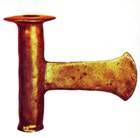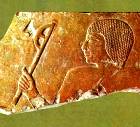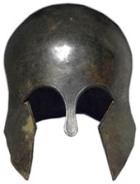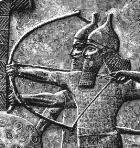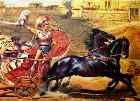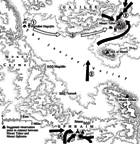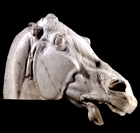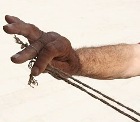Bible Warfare: Battle Armor
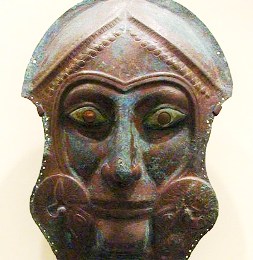
Greek mask of a helmeted warrior
Think of the brutal weapons used in ancient (and modern) wars. They can kill a soldier quickly. The trick is, not to let them near you.
So how do you defend yourself? With armor.
Armor in ancient battles
A coat of mail or metal armor was vitally important to any high-ranking soldier in the ancient world.
- A foot soldier could get away with less armor
- but leaders were always the focus of attack.
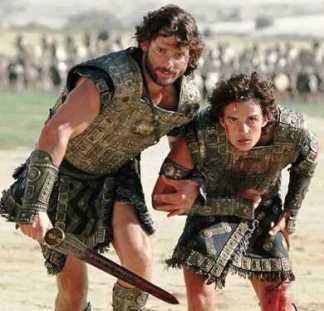
Scale Armor worn in the film ‘Troy’
If a soldier could kill an enemy leader, there would be panic and confusion, and a better chance of routing the enemy, so any high-ranking officer was a target.
This is what happened to King Ahab at Ramoth-Gilead. The Bible story notes that an arrow struck him between the scale armor and the breastplate, and he died soon after (see the story of Ahab’s death at ’10 Bible Warriors’).
This focus on the leader has not changed, of course. The proportion of officers (from both sides) killed in the battles of World War I was higher than the proportion of enlisted men, even though the numbers of enlisted men killed were, of course, greater.
Wearing armor: good or bad?
There were two advantages of armor:
- it covered the body of the soldier, protecting his chest and body
- it left his hands free to use his weapons.
There were two disadvantages:
- it was difficult and expensive to make and had to be repaired and maintained
- it was heavy, and hampered the movement of the soldier.
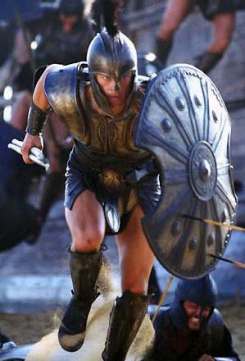
Achilles in leather armor, from ‘Troy’
Leather armor
The easiest way to get around these problems was to use armor made of leather or some other tough material – light but strong. This was simple to make and maintain, but not as protective as metal armor.
It may have been alright for the (nearly) invulnerable hero Achilles in the film ‘Troy’, see Youtube video of the scene, but was less valuable to an ordinary soldier.
The Coat of Mail
The big advance in armor came with the introduction of the coat of mail.
This ‘coat’ was made from hundreds of small pieces of metal, like fish scales, which were joined together and attached to an under-shirt of cloth or leather that reached from shoulder to thigh.
It was (reasonably) light, and it moved with the wearer – unlike armor made of sheets of metal (see image of early Greek armor at bottom of this page).
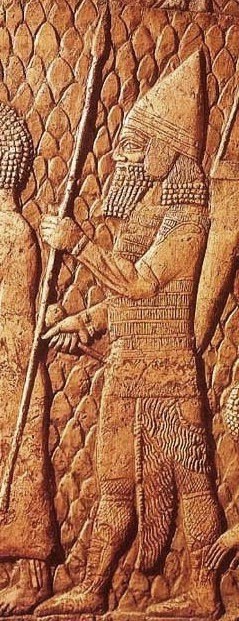
Wall relief, Sennacherib’s conquest of Lachish
The coat of mail had definite advantages over solid metal armor:
- it was relatively light
- it was effective, protecting the soldier from arrows and spears
- it was much easier to make than solid armor: small rectangles of metal perforated at each corner are far easier to make and shape than, for example, a one-piece breastplate.
This type of armor laid the groundwork for a later development in armor, chain mail.
A coat of chain mail
There was a downside, of course.
- Making a coat of mail needed specialized technical skills, and this made it costly.
- It also left the soldier vulnerable at the shoulder where the sleeve joined – and of course an arrow could pierce between the metal scales.
All of this was irrelevant to the Israelites in the early part of biblical history. Their Canaanite and Philistine overlords forbad them the use of iron and smelting works, so that they could not manufacture weapons – or even repair them effectively. They were even reduced to going to a Canaanite smithy to repair their ploughshares.
But later on, when they gained control of their territory, this changed – as did warfare itself.
Nothing is known about the shape of Hebrew helmets, though there are plenty of illustrations of those of other peoples such as the Assyrians (see right). The helmet was called a ‘koba‘ and was usually made of bronze (1 Samuel 17:5, 2 Chronicles 26:14).
Armor for elite warriors
In the first millennium BC the charioteer and the archer became more important in battle. Since they needed both hands to fight, they could not protect their body with a shield.
They were often accompanied by a shield bearer, but this meant that three men had to occupy one chariot – and chariots were lightweight, built for speed. They became cumbersome and often broke under the weight of three men.
The coat of mail provided the solution. It was reasonably light, hard, and flexible.
But since it was so expensive, it was given only to those who needed it most – and this of course was the charioteers and archers.
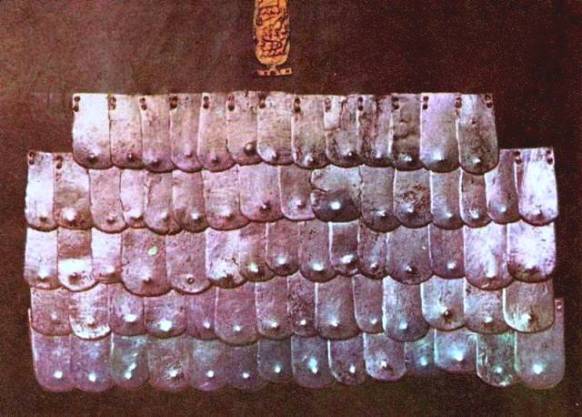
Scale armor, made of metal scales rounded at the ends and sewn on to linen or leather linings. One suit could have as many as a thousand such scales. Horses were also given a special protective armor.
An Egyptian artist, recording a victory of Thutmose IV, shows the weak spots of a coat of mail (below right). An arrow has struck the charioteer in the armpit, where the sleeve joins the body of the coat.
The artist has also shown the shape of the scales, rectangular with the bottom edge sloping into a point and a protruding spine down the center.
These large scales must have been heavy, and in time they were made smaller. Rameses II wore a coat with much smaller scales at the Battle of Kadesh. It seems from the lists of military equipment in the Nuzi archives that the bigger and better the coat, the larger the number of small scales.
Armor in the Bible
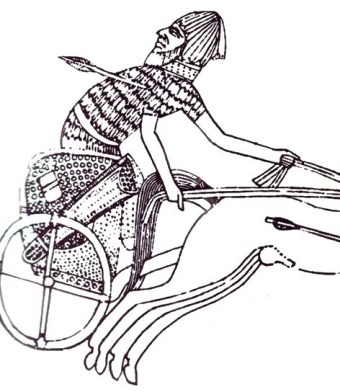
Line drawing of wall relief showing scale armor pierced by an arrow shot by Thurmosis IV
There is one graphic description of the disadvantage of scale armor in 1 Kings 22:
‘ so the king of Israel went into battle. Now the king of Aram had commanded the thirty-two captains of his chariots, “Fight with no one small or great, but only with the king of Israel.” When the captains of the chariots saw Jehoshaphat, they said “It is surely the king of Israel.” So they turned to fight against him; and Jehoshaphat cried out.
When the captains of the chariots saw that it was not the king of Israel, they turned back from pursuing him. But a certain man drew his bow and unknowingly struck the king of Israel between the scale armor and the breast-plate; so he said to the driver of his chariot “Turn around, and carry me out of the battle, for I am wounded.”
The battle grew hot that day, and the king was propped up in his chariot facing the Arameans, until at evening he died; the blood from the wound had flowed into the bottom of the chariot… ‘ (1 Kings 22:30-35)
The coat of mail worn by the warrior king Ahab had shown its fatal weakness.
During the biblical period, armor developed into a sophisticated part of a soldier’s equipment. The scale armor or coat of mail was vitally important to warriors, especially charioteers or archers who needed both hands to fight.
The story of the death of King Ahab, husband of Jezebel and an unsung military hero of the Bible, shows that even the best armor could not guarantee a soldier’s safety.
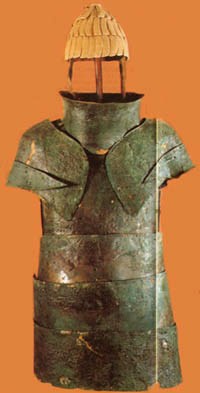
During the Bible period, a warrior’s armor developed from the primitive bronze plates wrapped around the body, as in the Greek armor above, to sophisticated Assyrian scale armor – see below
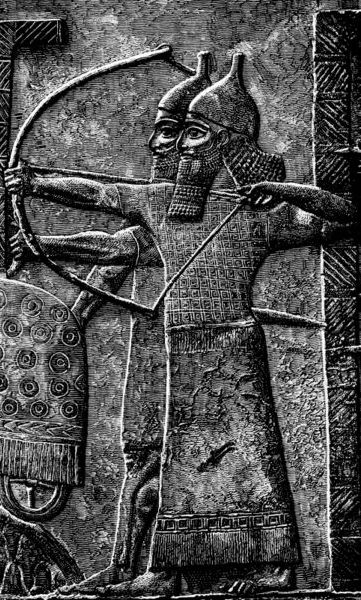
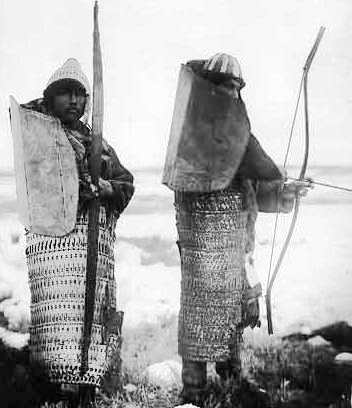
Asiatic Koryak armor, late 19th century
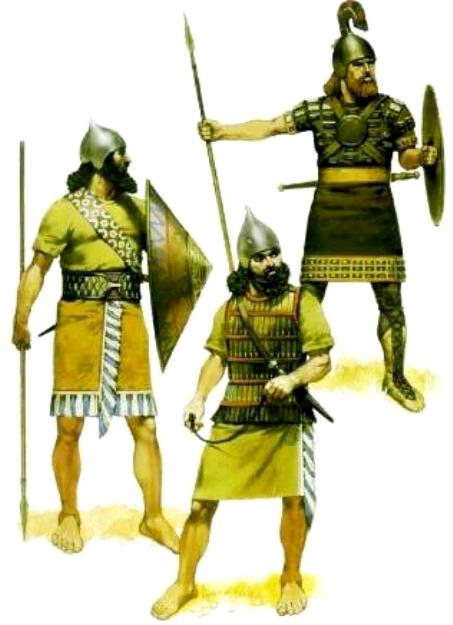
The armor and weapons of Assyrian foot-soldiers
Search Box
![]()
Battle Armor – links
__________
© Copyright 2006
Elizabeth Fletcher




